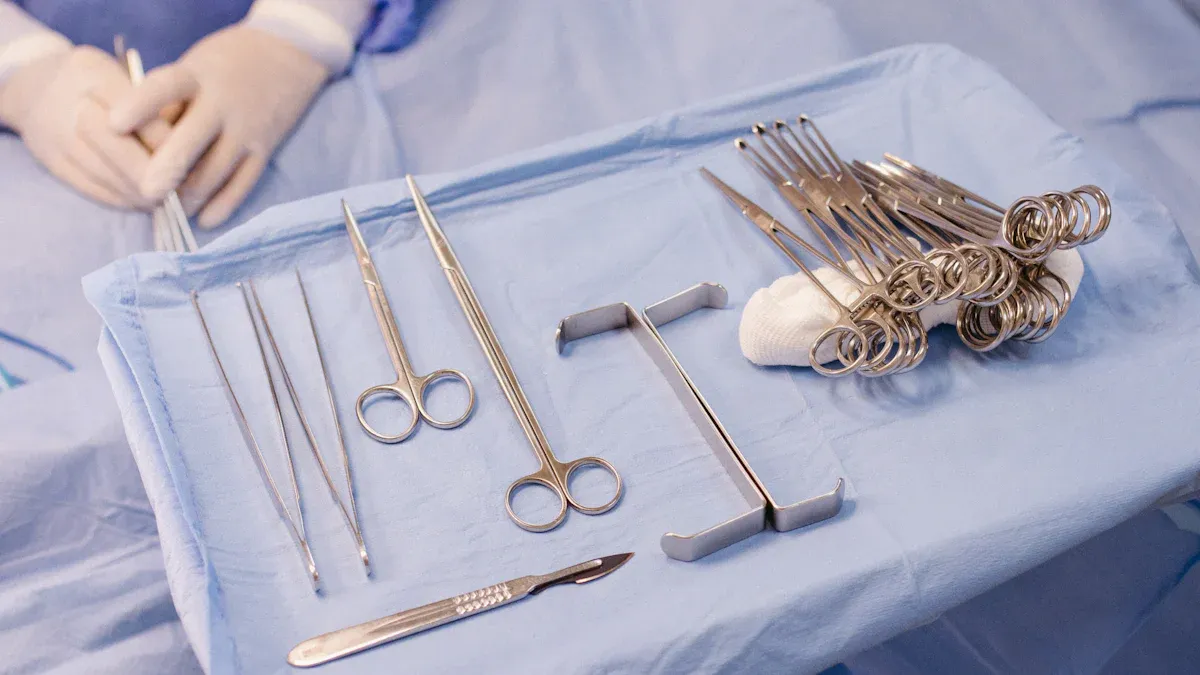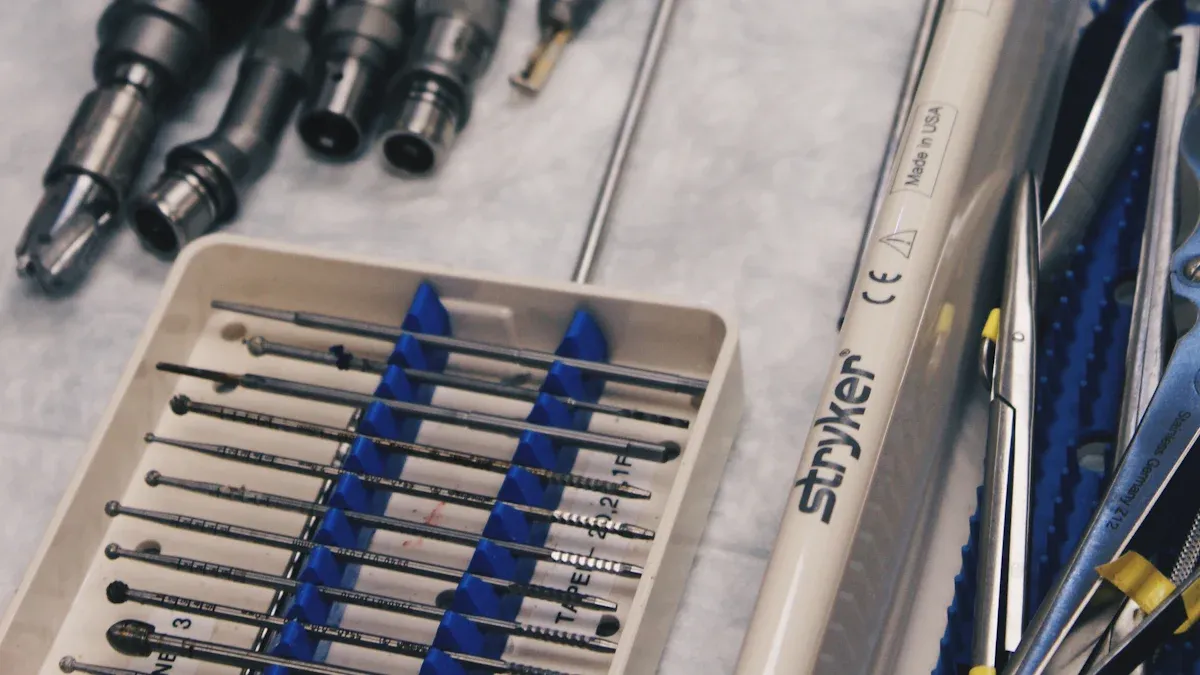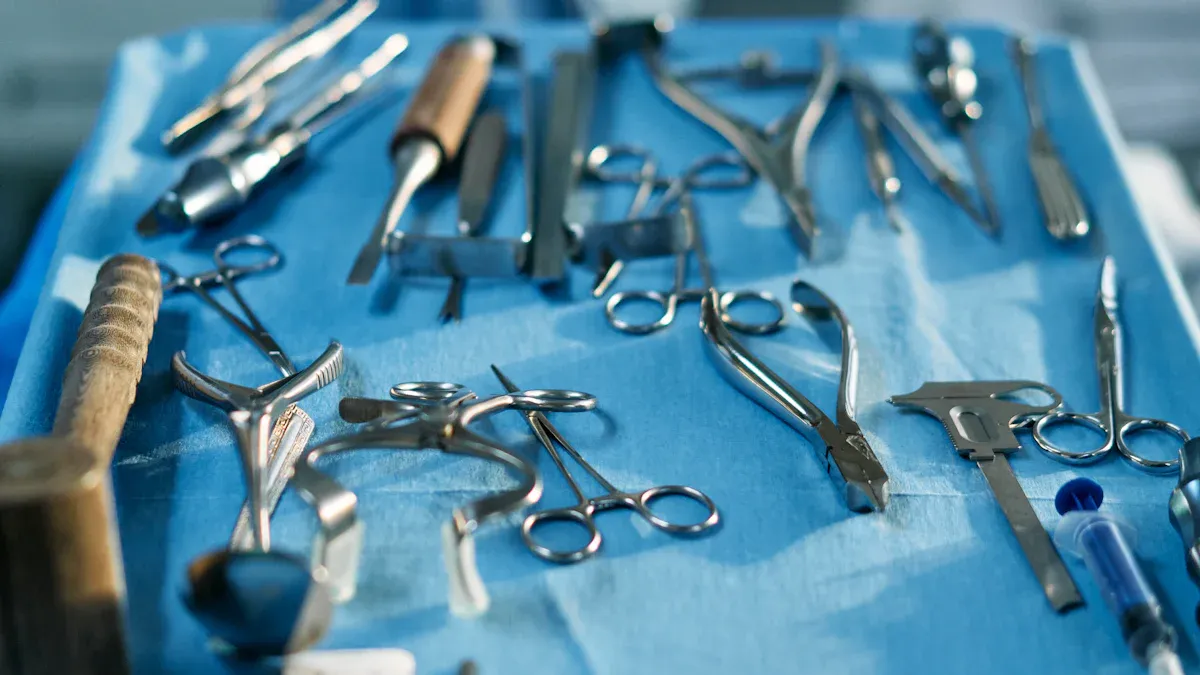What Makes Nitinol Tubing Ideal for MRI-Compatible Surgical Tools

Nitinol tubing has transformed the design of MRI-compatible nitinol tubing for surgical tools due to its exceptional properties. Its non-ferromagnetic nature ensures safety in MRI environments, as no magnetic attraction occurs even during high-field imaging. Studies confirm that nitinol avoids image artifacts and maintains MRI clarity, making it ideal for precision procedures. Additionally, its biocompatibility minimizes risks like inflammation or thrombosis, supporting safer long-term medical applications. The material’s resistance to corrosion and rejection further enhances its performance, particularly in demanding surgical environments. These attributes highlight why MRI-compatible nitinol tubing for surgical tools is indispensable for modern medical applications.
Key Takeaways
Nitinol tubing is safe for MRI because it doesn’t stick to magnets.
Nitinol can bend and snap back, making tools flexible and accurate.
Nitinol works well with the body, lowering risks like swelling or rejection.
Polishing nitinol makes it stronger against rust and safer for medical use.
Nitinol is tough and doesn’t kink, so it’s great for hard surgeries.
Material Properties of MRI-Compatible Nitinol Tubing

Composition and Alloy Characteristics
Nitinol, a shape memory alloy, is composed of nearly equal parts nickel and titanium. This precise composition is critical for its unique properties, including superelasticity and shape memory. Manufacturing processes such as vacuum arc melting and powder metallurgy ensure the alloy's consistency and quality. These methods allow for precise control over the nickel-to-titanium ratio, which directly influences the material's phase transition temperature and mechanical behavior.
Surface analysis of nitinol tubing reveals variability in nickel concentration, ranging from 0.5% to 15%, depending on the supplier. Heat treatment at 500°C significantly alters the surface composition, increasing nickel concentration and promoting complete nickel oxidation. These controlled processes enhance the alloy's performance in medical applications, ensuring reliability and safety.
Superelasticity and Shape Memory
The superelasticity of nitinol enables it to undergo significant deformation and return to its original shape without permanent damage. This property is particularly valuable in surgical tools, where flexibility and precision are essential. Stress-induced phase changes allow nitinol to transform from its austenitic phase to martensite under applied stress, enabling deformation. Once the stress is removed, the material reverts to its original phase, restoring its shape.
Experimental data highlights nitinol's remarkable strain recovery capabilities. Samples pre-strained below the martensitic finish temperature (Mf) achieve full recovery when exposed to heat. Stress-strain curves demonstrate a plateau during deformation, indicating the austenite-to-martensite transformation. These characteristics make nitinol wires indispensable in applications requiring adaptability to complex anatomical structures.
Evidence Type | Description |
|---|---|
Transformation Temperatures | Ms and As curves intersect at approximately 170 MPa under varying stresses. |
Strain Recovery | Samples pre-strained below Mf achieve full strain recovery when heated. |
Stress-Induced Phase Changes | Stress applied in austenitic phase transforms nitinol to martensite. |
Mechanical Testing | Stress-strain curves show a plateau during deformation. |
Alloy Composition | Nitinol alloys with niobium enhance superelasticity and phase changes. |
Corrosion Resistance and Biocompatibility
Nitinol's biocompatibility and corrosion resistance make it ideal for medical applications. The material resists breakdown in harsh environments, ensuring long-term durability. Electropolished nitinol tubing demonstrates exceptional corrosion resistance, with a breakdown potential of up to 1000 mV. This property minimizes the risk of material degradation, even in demanding surgical environments.
Biocompatibility is another critical advantage of nitinol. The alloy reduces rejection rates when used in medical implants, lowering the risk of inflammation or thrombosis. Its ability to maintain structural integrity and resist corrosion ensures safe and effective performance in applications such as nitinol wires, guidewires, and catheters. These attributes make nitinol tubing a cornerstone of modern medical technology.
MRI Compatibility of Nitinol
Non-Ferromagnetic Properties
Nitinol exhibits non-ferromagnetic behavior, making it an excellent choice for MRI environments. Unlike ferromagnetic materials, nitinol does not interact with magnetic fields. This property ensures that surgical tools made from nitinol tubing remain stable and unaffected during MRI procedures. The absence of magnetic attraction eliminates the risk of sudden movements or displacements, which could compromise patient safety.
Medical professionals rely on nitinol guide wires and catheters for procedures conducted under real-time MRI imaging. These tools maintain their position and functionality without interference from the strong magnetic fields generated by MRI machines. This unique compatibility allows surgeons to perform precise interventions while ensuring the safety and compatibility of the tools used.
Resistance to Heating and Artifacts
Nitinol tubing demonstrates remarkable resistance to heating and artifact formation during MRI procedures. When exposed to the electromagnetic fields of an MRI scanner, some materials can heat up due to induced currents. However, nitinol's low electrical conductivity minimizes this effect, ensuring that it remains cool and safe for use in medical applications.
Artifact formation in MRI imaging can obscure critical details, making it challenging to obtain accurate diagnostic information. Nitinol tubing significantly reduces the risk of artifacts, preserving the clarity of MRI images. This feature is particularly valuable in procedures requiring high-resolution imaging, where even minor distortions could impact clinical outcomes.
Tip: The combination of nitinol's resistance to heating and its ability to minimize artifacts makes it a preferred material for MRI-compatible surgical tools, ensuring both patient safety and imaging accuracy.
Enhanced Safety with Electropolished Nitinol
Electropolishing further enhances the safety and compatibility of nitinol tubing in MRI applications. This surface treatment process removes impurities and creates a smooth, uniform finish. The electropolished surface reduces the risk of corrosion and improves the material's biocompatibility, making it ideal for use in medical devices.
Electropolished nitinol tubing also exhibits superior resistance to breakdown under the intense conditions of MRI environments. The process eliminates surface irregularities that could contribute to localized heating or artifact formation. As a result, surgical tools made from electropolished nitinol maintain their integrity and performance during MRI procedures, ensuring optimal safety for patients and healthcare providers alike.
Advantages of Nitinol in Surgical Tools

Flexibility and Precision in Design
Nitinol's unique properties, such as superelasticity and shape memory, make it an exceptional material for designing surgical instruments. These characteristics allow nitinol wires to bend and adapt to complex anatomical structures without losing their original shape. This flexibility is particularly valuable in robotic-assisted surgeries, where precision is critical.
The ability of nitinol to navigate confined spaces enhances its performance in minimally invasive procedures. For example, nitinol guide wires can maneuver through tight and intricate pathways, reducing the risk of procedural errors. Additionally, the material's adaptability ensures that spinal implants maintain their shape and fit perfectly, improving patient comfort.
Note: The flexibility and precision of nitinol-based surgical tools contribute to their effectiveness in a wide range of medical applications, from neurovascular stents to orthopedic implants.
Durability and Kink Resistance
The durability and longevity of nitinol tubing make it ideal for surgical tools used in demanding environments. Nitinol exhibits exceptional resistance to fatigue, ensuring structural integrity during repeated use. Its corrosion resistance, enhanced by electropolishing, allows it to withstand harsh bodily environments without degrading over time.
Nitinol guide wires demonstrate remarkable kink resistance, maintaining their mechanical stability even under significant strain. This property is crucial for tools used in minimally invasive procedures, where consistent performance is essential. Clinical studies have shown that nitinol devices outperform traditional materials like stainless steel in terms of durability and flexibility.
Property | Nitinol Tubing | Traditional Materials (e.g., Steel) |
|---|---|---|
Resistance to Deformation | Excellent, ideal for load-bearing | Limited, prone to deformation |
Corrosion Resistance | Superior, up to 1000 mV | Lower, varies significantly |
Flexibility | Superior flexibility and durability | Limited flexibility |
Applications in Nitinol Guide Wires and Catheters
Nitinol guide wires and catheters are indispensable in modern medical applications. Their superelasticity and shape memory properties enable them to navigate through complex anatomical pathways with ease. These tools are particularly effective in coronary interventions, where precision and flexibility are paramount.
Research has shown that nitinol guide wires reduce procedural complications by 25% compared to stainless steel alternatives. Their superior torque control and flexibility make them a preferred choice for minimally invasive procedures. Additionally, nitinol's biocompatibility ensures safety and reliability, reducing the risk of complications such as inflammation or rejection.
The advantages of using nitinol extend to stents and guidewires, where its durability and flexibility enhance patient outcomes. A study published in the Journal of the American College of Cardiology found that nitinol self-expanding stents had a primary patency rate of 83.2% at 12 months, significantly outperforming balloon-expandable stents. These findings highlight the critical role of nitinol in advancing surgical tools and improving patient care.
Manufacturing and Quality Assurance for Nitinol Tubing
High-Precision Manufacturing Techniques
The production of nitinol wires demands advanced manufacturing techniques to achieve the precision required for medical applications. Processes like additive manufacturing and laser cutting enable the creation of intricate designs tailored to specific patient needs. Automation and AI-driven quality control systems monitor every stage of production, ensuring consistent quality and reducing human error. Non-destructive testing methods, such as ultrasonic testing, validate the integrity of nitinol tubing without causing damage.
Dimensional accuracy plays a critical role in the performance of nitinol wires, especially in cardiovascular devices. Regular inspections verify wall thickness uniformity and outer diameter stability. Material composition testing ensures the correct nickel-titanium ratio, which is essential for maintaining the unique properties of nitinol. Compliance with ISO 13485 certification further underscores the commitment to producing safe and reliable products for medical applications.
Parameter | Specification |
|---|---|
Outer Diameter | Typically 1.61 mm for capillary tubing |
Wall Thickness | Ranges from 0.1 mm to 15 mm |
Length | Can extend up to 6000 mm |
Compliance Standard | ISO 13485 certification |
Testing for MRI Compatibility and Biocompatibility
Rigorous testing protocols validate the MRI compatibility and biocompatibility of nitinol wires. MRI testing involves assessing the material's interaction with magnetic fields and its impact on imaging quality. Studies show that nitinol exhibits minimal susceptibility differences compared to brain tissue, ensuring it does not degrade MRI images. T2-weighted imaging of nitinol wires in a brain phantom confirmed no significant artifacts or distortions, with artifact sizes comparable to the tubing dimensions.
Biocompatibility testing ensures the material's safety for medical applications. Non-destructive testing methods detect flaws, while dimensional and mechanical inspections verify performance. Compliance with ASTM and ISO standards guarantees that nitinol wires meet stringent medical-grade requirements. These measures ensure the safety and reliability of nitinol in critical procedures.
Aspect | Details |
|---|---|
MRI Compatibility | Nitinol and brass exhibit less than 10−3 susceptibility difference with brain tissue, allowing for accommodation in the imaging region without significant image degradation. |
Testing Method | T2-weighted, 3D SPACE volumetric images were acquired of MINT inserted in a brain imaging phantom prepared with 2.9 wt% agarose and doped with NiCl2 and NaCl. The imaging was performed in a 3T Siemens Trio scanner. |
Results | Images showed no significant artifact or distortion, with a measured artifact size of 3 mm in the sagittal plane and 3.3 mm in the transverse plane, comparable to the shaft dimensions (O.D. = 3 mm). |
Adherence to Medical Quality Standards
Adherence to medical quality standards is essential for ensuring the safety and performance of nitinol wires. Compliance with ASTM F2063 defines the chemical composition and mechanical properties of nitinol, requiring rigorous testing to validate material performance. Manufacturers conduct tensile strength assessments and thermal analysis to meet these criteria.
Regulatory compliance minimizes risks associated with non-conformance, such as product recalls or legal penalties. Laser micrometry and ultrasonic testing validate tolerances, ensuring dimensional accuracy and performance characteristics. Advanced monitoring systems maintain dimensional stability, while statistical studies confirm superior fatigue performance. These measures ensure that nitinol wires meet the highest standards for medical applications.
Note: Compliance with ASTM and ISO benchmarks enhances the reliability of nitinol wires, making them indispensable in modern medical applications.
Nitinol tubing has become a cornerstone in revolutionizing healthcare, particularly in MRI-compatible surgical tools. Its non-ferromagnetic nature ensures safety during imaging, while its biocompatibility minimizes adverse reactions, making it indispensable in medical applications. The material's unique properties, such as superelasticity and shape memory, enable precise and flexible designs for surgical instruments.
The growing prevalence of chronic diseases and advancements in minimally invasive surgeries highlight the increasing demand for nitinol-based solutions. For instance, innovations like additive manufacturing allow for customized nitinol tubing, enhancing device effectiveness. Additionally, the integration of smart technologies, such as embedded sensors, improves surgical safety and outcomes.
Evidence Type | Description |
|---|---|
Prevalence of Chronic Diseases | The increasing prevalence of chronic diseases, especially cardiovascular diseases, drives demand for effective treatment options. |
Growth in Minimally Invasive Surgeries | Projected growth at a CAGR of over 10% highlights the rising need for high-quality Nitinol tubes. |
Advancements in Manufacturing | Innovations like additive manufacturing allow for customized Nitinol tubes, enhancing device effectiveness. |
Integration of Smart Technologies | Nitinol tubes with embedded sensors enable real-time monitoring, improving surgical safety and outcomes. |
Nitinol's long-term performance further solidifies its impact on the healthcare industry. Clinical studies confirm its ability to reduce risks associated with foreign materials, ensuring safer outcomes in neurovascular procedures. Its durability and fatigue resistance make it a reliable choice for critical surgical applications. These attributes underscore why MRI-compatible nitinol tubing for surgical tools remains a vital component in modern medicine.
FAQ
What makes nitinol tubing suitable for MRI environments?
Nitinol tubing is non-ferromagnetic, ensuring it does not interact with MRI magnetic fields. This property eliminates risks like sudden movements or image distortions, making it safe and reliable for MRI-compatible surgical tools.
How does electropolishing improve nitinol tubing?
Electropolishing removes surface impurities and creates a smooth finish. This process enhances corrosion resistance, biocompatibility, and durability, ensuring nitinol tubing performs effectively in demanding medical environments.
Why is superelasticity important in surgical tools?
Superelasticity allows nitinol tubing to bend and return to its original shape without damage. This flexibility is crucial for navigating complex anatomical pathways during minimally invasive procedures.
Are nitinol surgical tools durable?
Yes, nitinol tools resist fatigue and corrosion, ensuring long-term performance. Their kink resistance and structural integrity make them ideal for repeated use in challenging surgical applications.
What medical devices commonly use nitinol tubing?
Nitinol tubing is widely used in guide wires, catheters, stents, and orthopedic implants. Its unique properties, such as shape memory and biocompatibility, make it indispensable in these applications.
See Also
The Importance of Nitinol Tubing in Minimally Invasive Surgery
Nitinol Tubing's Critical Role in Modern Medical Technologies
The Manufacturing Process of Nitinol Tubing for Healthcare
Nitinol Tubing's Impact on the Future of Medical Devices
Investigating Nitinol Tubing Uses in Healthcare Technologies

